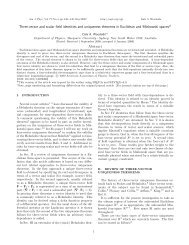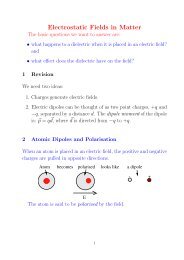<strong>Chapter</strong> 8 <strong>Vector</strong> <strong>Spaces</strong> <strong>in</strong> <strong>Quantum</strong> <strong>Mechanics</strong> 985. The m<strong>in</strong>imum number of vectors needed to form a complete set of basis states isknown as the dimension of the state space. [In many, if not most cases of <strong>in</strong>terest<strong>in</strong> quantum mechanics, the dimension of the state space is <strong>in</strong>f<strong>in</strong>ite.]It should be noted that there is an <strong>in</strong>f<strong>in</strong>ite number of possible sets of basis states for anystate space. The arguments presented above by which we arrive at a set of basis states (or<strong>in</strong>termediate states) serves as a physically motivated start<strong>in</strong>g po<strong>in</strong>t to construct the statespace for the system. But once we have def<strong>in</strong>ed the state space <strong>in</strong> this way, there is noreason why we cannot, at least mathematically, construct other sets of basis states. Thesebasis states that we start with are particularly useful as they have an immediate physicalmean<strong>in</strong>g; this might not be the case for an arbitrary basis set. But there are other meansby which other physically mean<strong>in</strong>gful basis states can be determ<strong>in</strong>ed: often the choice ofbasis states is suggested by the physics (such as the set of eigenstates of an observable,see <strong>Chapter</strong> 9).8.5.2 Probability Amplitudes and the Inner Product of State <strong>Vector</strong>sWe obta<strong>in</strong>ed a number of properties of probability amplitudes when look<strong>in</strong>g at the caseof a sp<strong>in</strong> half system. Some of the results obta<strong>in</strong>ed there, and a few more that were not,are summarized <strong>in</strong> the follow<strong>in</strong>g.If |φ〉 and |ψ〉 are any two state vectors belong<strong>in</strong>g to the state space H, then1. 〈φ|ψ〉, a complex number, is the probability amplitude of observ<strong>in</strong>g the system tobe <strong>in</strong> the state |φ〉 given that it is <strong>in</strong> the state |ψ〉.2. The probability of observ<strong>in</strong>g the system to be <strong>in</strong> the state |φ〉 given that it is <strong>in</strong> thestate |ψ〉 is |〈φ|ψ〉| 2 .The probability amplitude 〈φ|ψ〉, can then be shown to have the properties3. 〈φ|ψ〉 = 〈ψ|φ〉 ∗ .4. (〈φ|{c 1 |ψ 1 〉 + c 2 |ψ 2 〉} = c 1 〈φ|ψ 1 〉 + c 2 〈φ|ψ 2 〉 where c 1 and c 2 are complex numbers.5. 〈ψ|ψ〉 ≥ 0. If 〈ψ|ψ〉=0 then |ψ〉 = 0, the zero vector.This last statement is related to the physically reasonable requirement that the probabilityof a system be<strong>in</strong>g found <strong>in</strong> a state |ψ〉 given that it is <strong>in</strong> the state |ψ〉 has to be unity,i.e. |〈ψ|ψ〉| 2 = 1 which means that 〈ψ|ψ〉 = exp(iη). We now choose η = 0 so that〈ψ|ψ〉 = 1, which is bigger than zero. But recall that any multiple of a state vector stillrepresents the same physical state of the system, i.e. |˜ψ〉 = a|ψ〉 still represents the samephysical state as |ψ〉. However, <strong>in</strong> this case, 〈˜ψ|˜ψ〉 = |a| 2 which is not necessarily unity,but is is certa<strong>in</strong>ly bigger than zero.6. The quantity √ 〈ψ|ψ〉 is known as the length or norm of |ψ〉.7. A state |ψ〉 is normalized, or normalized to unity, if 〈ψ|ψ〉 = 1.
<strong>Chapter</strong> 8 <strong>Vector</strong> <strong>Spaces</strong> <strong>in</strong> <strong>Quantum</strong> <strong>Mechanics</strong> 99Normalized states are states for which probability is properly taken <strong>in</strong>to account. It ismathematically convenient to permit the use of states whose norms are not equal to unity,but it is necessary <strong>in</strong> order to make use of the probability <strong>in</strong>terpretation to deal only withthat state which has norm of unity. Any state that cannot be normalized to unity (i.e. it isof <strong>in</strong>f<strong>in</strong>ite length) cannot represent a physically acceptable state.8. Two states |φ〉 and |ψ〉 are orthogonal if 〈φ|ψ〉 = 0.The physical significance of two states be<strong>in</strong>g orthogonal should be understood: for asystem <strong>in</strong> a certa<strong>in</strong> state, there is zero probability of it be<strong>in</strong>g observed <strong>in</strong> a state withwhich it is orthogonal. In this sense, two orthogonal states are as dist<strong>in</strong>ct as it is possiblefor two states to be.F<strong>in</strong>ally, a set of orthonormal basis vectors {|ϕ n 〉; n = 1, 2, . . . } will have the property9. 〈ϕ m |ϕ n 〉 = δ mn where δ mn is known as the Kronecker delta, and equals unity if m = nand zero if m n.All the above conditions satisfied by probability amplitudes were to a greater or lesserextent physically motivated, but it nevertheless turns out that these conditions are identicalto the conditions that are used to def<strong>in</strong>e the <strong>in</strong>ner product of two vectors <strong>in</strong> a complexvector space, <strong>in</strong> this case, the state space of the system, i.e. we could write, us<strong>in</strong>g theusual mathematical notation for an <strong>in</strong>ner product, 〈φ|ψ〉 = (|φ〉, |ψ〉). The state space ofa physical system is thus more than just a complex vector space, it is a vector spaceon which there is def<strong>in</strong>ed an <strong>in</strong>ner product, and so is more correctly termed a complex‘<strong>in</strong>ner product’ space. However, it is usually required <strong>in</strong> quantum mechanics that certa<strong>in</strong>convergency criteria, def<strong>in</strong>ed <strong>in</strong> terms of the norms of sequences of vectors belong<strong>in</strong>g tothe state space, must be satisfied. This is not of any concern for spaces of f<strong>in</strong>ite dimension,but are important for spaces of <strong>in</strong>f<strong>in</strong>ite dimension. If these criteria are satisfied then thestate space is said to be a Hilbert space. Thus rather than referr<strong>in</strong>g to the state space of asystem, reference is made to the Hilbert space of the system.It is important to recognize that all the vectors belong<strong>in</strong>g to a Hilbert space have f<strong>in</strong>itenorm, or, putt<strong>in</strong>g it another way, all the state vectors can be normalized to unity – thisstate of affairs is physically necessary if we want to be able to apply the probability <strong>in</strong>terpretation<strong>in</strong> a consistent way. However, as we shall see, we will encounter states whichdo not have a f<strong>in</strong>ite norm and hence neither represent physically realizable states, nor dothey belong to the state or Hilbert space of the system. Nevertheless, with proper care regard<strong>in</strong>gtheir use and <strong>in</strong>terpretation, such states turn out to be essential, and play a crucialrole throughout quantum mechanics. Recogniz<strong>in</strong>g that a probability amplitude is noth<strong>in</strong>gbut an <strong>in</strong>ner product on the state space of the system, leads to a more general way ofdef<strong>in</strong><strong>in</strong>g what is meant by a bra vector. The follow<strong>in</strong>g discussion emphasizes the fact thata bra vector, while it shares many characteristices of a ket vector, is actually a differentmathematical entity.Bra <strong>Vector</strong>sWe have consistently used the notation 〈φ|ψ〉 to represent a probability amplitude, but wehave just seen that this quantity is <strong>in</strong> fact noth<strong>in</strong>g more than the <strong>in</strong>ner product of two state
















